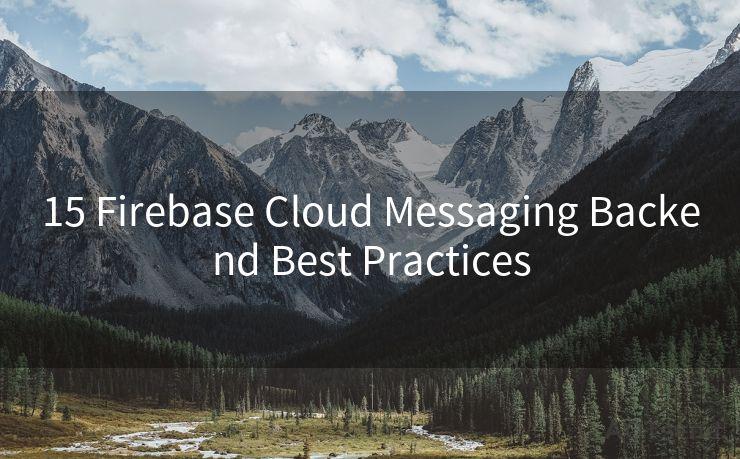15 Firebase Cloud Messaging Backend Best Practices




Firebase Cloud Messaging (FCM) is a powerful tool for sending notifications and data messages to Android, iOS, and Web applications. To ensure your backend integration with FCM is as efficient and effective as possible, here are 15 best practices to follow:
1. Understand the FCM Architecture
Before integrating FCM into your backend, it's crucial to understand its architecture and how it fits into your overall system. This knowledge will help you design a more robust and scalable solution.
2. Secure Your Server Key
Protect your server key, as it's used to authenticate your server with FCM. Never expose this key publicly or share it with unauthorized individuals.
3. Optimize Message Targeting
Use FCM's targeting capabilities to send messages to specific user segments. This ensures that your messages are relevant and engaging, increasing user engagement.
4. Leverage Topic Messaging
Utilize FCM's topic messaging feature to send messages to multiple devices subscribed to a specific topic. This is an efficient way to broadcast messages to a large audience.
5. Prioritize Your Messages
Set the priority of your messages appropriately. High-priority messages are delivered immediately, while normal priority messages are batched and sent at a later time.
6. Handle Retries and Expiration
Implement retry mechanisms for failed message deliveries and set expiration times for messages to ensure they don't become stale.
7. Monitor and Log
Monitor your FCM integration closely and log all activities. This helps in identifying and troubleshooting issues quickly.
8. Optimize Payload Size
Keep your message payload size optimized to ensure fast and efficient delivery. Avoid sending unnecessary or redundant data.
9. Utilize Data Messages
In addition to notification messages, use data messages to send custom key-value pairs to your client apps. This allows for more flexible and dynamic messaging.
10. Test in a Production-Like Environment
Before deploying to production, test your FCM integration in a production-like environment to ensure it performs as expected under real-world conditions.
11. Handle Device Token Updates
Device tokens can change, so make sure your backend can handle token updates gracefully.
12. Consider Battery and Data Usage

Be mindful of the impact of frequent messaging on users' battery life and data usage. Optimize your messaging strategy to minimize these impacts.
13. Implement Push Notification Analytics
Track and analyze your push notification performance to understand user engagement and improve your messaging strategy.
14. Follow Best Practices for Push Notifications
Adhere to best practices for push notifications, such as sending relevant and timely messages, avoiding spam, and respecting user preferences.
15. Stay Up to Date with FCM Updates
Keep yourself updated with the latest FCM features and updates to ensure your integration remains efficient and secure.
🔔🔔🔔
【AOTsend Email API】:AOTsend is a Managed Email Service for sending transactional emails. Support Email Types: reminders, authentication, confirmations, notifications, verification codes, invoices, password resets, account activations, billing statements, two-factor authentication (2FA), and one-time passwords (OTP) emails, etc. $0.28 per 1000 Emails. 99% Delivery, 98% Inbox Rate.
You might be interested in:
Why did we start the AOTsend project, Brand Story?
What is a Managed Email API, How it Works?
Best 25+ Email Marketing Platforms (Authority,Keywords&Traffic Comparison)
Best 24+ Email Marketing Service (Price, Pros&Cons Comparison)
Email APIs vs SMTP: How they Works, Any Difference?
By following these best practices, you can ensure that your Firebase Cloud Messaging backend integration is optimized for performance, security, and user engagement. Remember, the key to a successful FCM implementation lies in understanding your users' needs and preferences, and tailoring your messaging strategy accordingly.




Scan the QR code to access on your mobile device.
Copyright notice: This article is published by AotSend. Reproduction requires attribution.
Article Link:https://www.mailwot.com/p5211.html



